#Tudor Renaissance
Text

Another drawing of Aurora. In a Tudor style dress. Inspired by @lolbeech ‘s comparisons between her and Anne Boleyn. She did marry Neptune 500+ years ago, maybe she lived during the Tudor era. Enjoy! Art by me.
[Aurora from the Emily Windsnap series in an Anne Boleyn-style dress, with her castle in the mist behind her. End description.]
#my artwork#emily windsnap#Emily Windsnap fanart#Aurora#Anne Boleyn#Tudor#Tudor Renaissance#renaissance#renaissance style#Renaissance dress#castle#fanart#traditional art#sketch#pencil#liz kessler#middle grade fiction#middle grade series
5 notes
·
View notes
Text
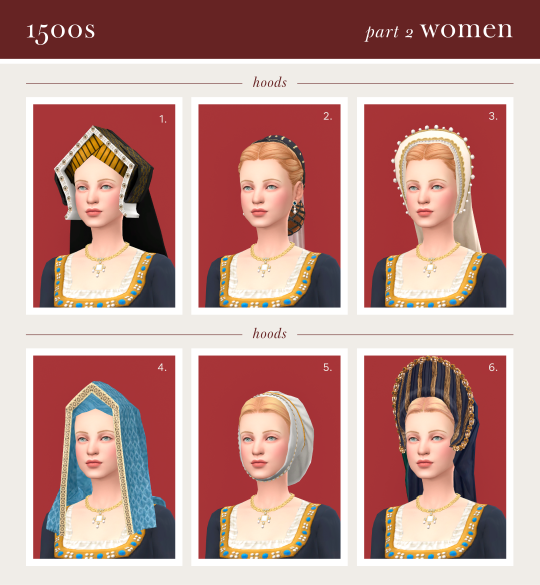
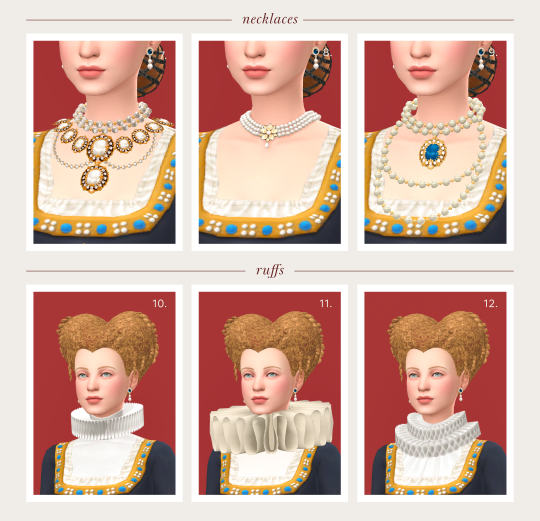

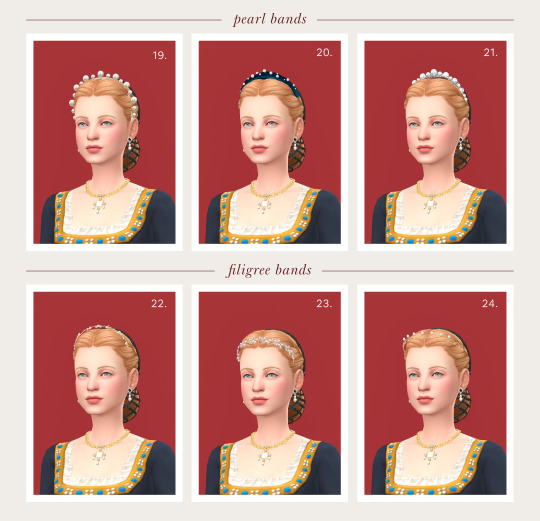

The 1400s gave way to the incredibly iconic accessories of the 1500s, namely hoods (both Gabled and French) and ruffs. While the end of the Tudor era saw the popularity of headdresses decline in favour of uncovered hair decorated with jewels, diadems, and feathers, prior to that headdresses were a vital part of court dress. In fact, the style of hood worn was often used as a political statement amongst the nobility. Hats had always been in fashion for men, but the 16th century saw them also become a fashion staple for women. CC links and reference images under the cut.
You can find more of my historical content here: 1300s ✺ 1400s ✺ 1500s ✺ 1600s
1 - Gabled Hood by Teanmoon
2 - Flemish Hood by Simverses
3 - French Hood by Teanmoon
4 - Tudor Gable Headpiece by Simverses
5 - Madeleine Hood by Melancholy Maiden
6 - Tudor French Hood by Simverses
7 - Anna Henrietta Necklace by Elfdor
8 - Tiffany Necklace by Sentate
9 - Anna Henrietta Necklace by Plaza Sims
10 - Vavilon Necklace by LEXEL_s
11 - Pierrot Ruffles by Sewerwolfx
12 - Ruff Collar by Strange Storyteller Sims
13 - Gargoyle Crown by MSSIMS
14 - Yellow Citrine Tiara by Glitterberry Sims
15 - Crown of Queen Mary by Bats From Westeros
16 - Art Deco Bandeau V2 by Glitterberry Sims
17 - Pearl Wedding Tiara by Glitterberry Sims
18 - Crystal Crown by S-Club (TSR)
19 - Madison Pearl Headband by Feyona (TSR)
20 - Thalita Headband by Sugar Owl (TSR)
21 - Pearl Hair Band by S-Club (TSR)
22 - Hair Accessory 202013 by S-Club (TSR)
23 - Head Accessory 201907 (TSR)
24 - Vintage Gold Tiara by Glitterberry Sims
25 - The Balzo Headdress by Simverses
26 - Kokoshnik by Bats From Westeros
27 - Artful Attifet by Teanmoon
28 - Floppy Feathet Hat by Simverses
29 - Mad Moxxi Hat by Plaza Sims
30 - Lady Hat V1 by Elfdor

With thanks to some amazing creators: @mssims @glitterberrysims @batsfromwesteros @teanmoon @simverses @the-melancholy-maiden @plazasims @elfdor @sentate @sewerwolfx @strangestorytellersims
#ts4#ts4 cc cas#the sims 4#ts4 decades challenge#sims 4 decades challenge#s4 cas#ts4 historical#ts4 history challenge#sims 4 history challenge#sims 4 historical#1500s#historical cc#tudor#16th century#ultimate decades challenge#renaissance
567 notes
·
View notes
Text

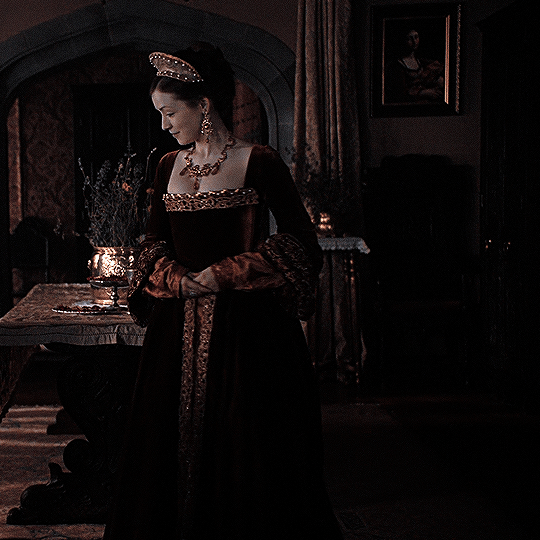

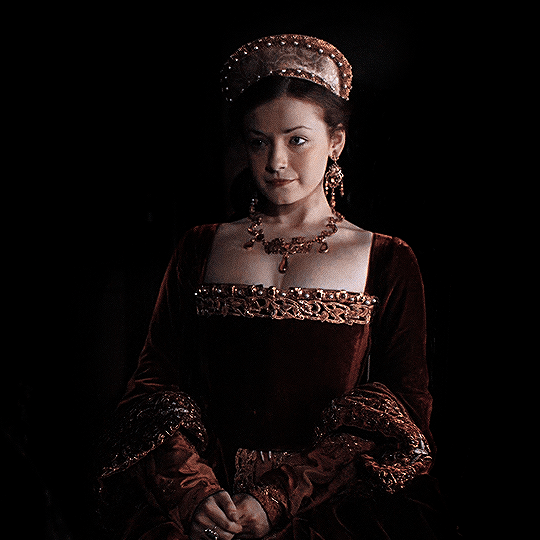
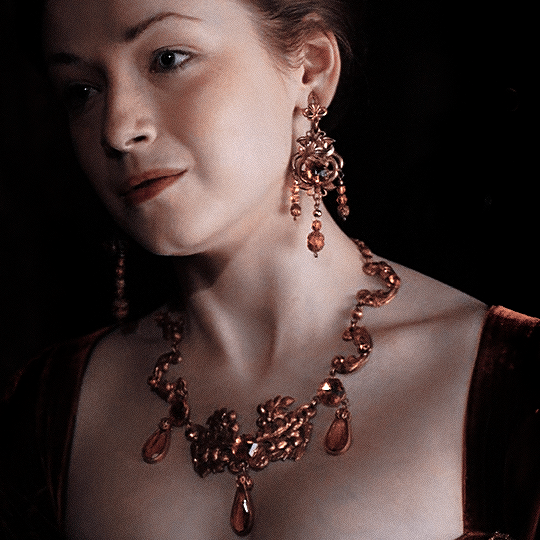
Sarah Bolger as Mary Tudor
THE TUDORS (2007–2010)
#☙#mary tudor#mary i#the tudors#sarah bolger#period drama#period dramas#tudoredit#thetudorsedit#thetudorsgifs#perioddramagif#perioddramaedit#perioddramacentral#weloveperioddrama#costumeedit#tudorerasource#renaissance era#tudor era#costume#❦ I make gifs ❦
863 notes
·
View notes
Text

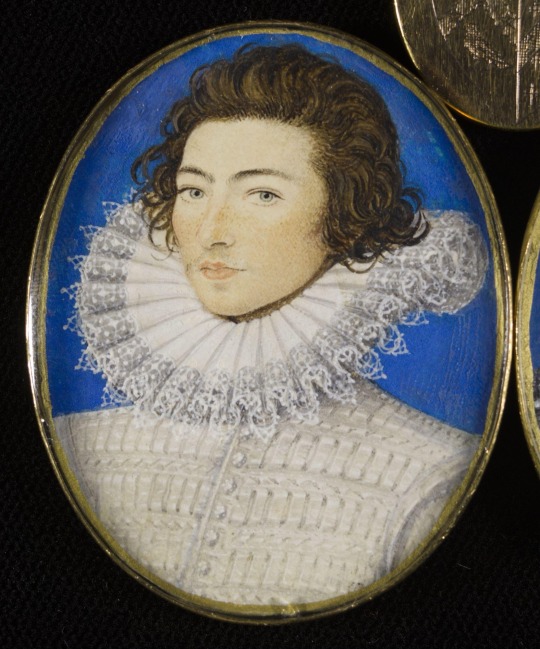

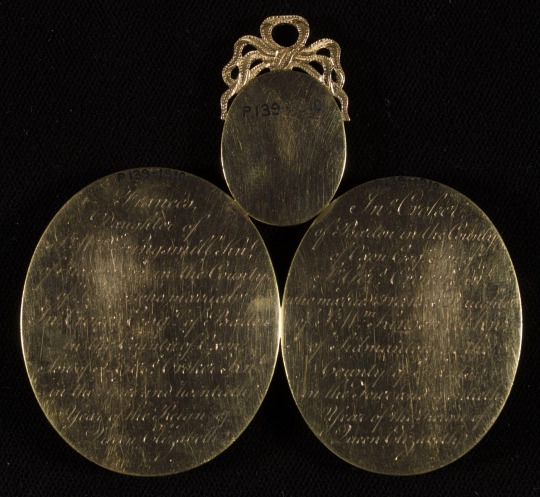
Miniature wedding portraits of Frances and John Croker of Barton by Nicolas Hilliard, circa 1581.
#freckles#early modern#early modern era#early modern period#english renaissance#english#renaissance#cool#portraits#portrait#painting#paintings#wedding#romance#love#couple#marriage#romantic#pretty#handsome#aesthetic#academia#history#fashion history#fashion#style#interesting#nicolas hilliard#elizabethan#tudor
216 notes
·
View notes
Text
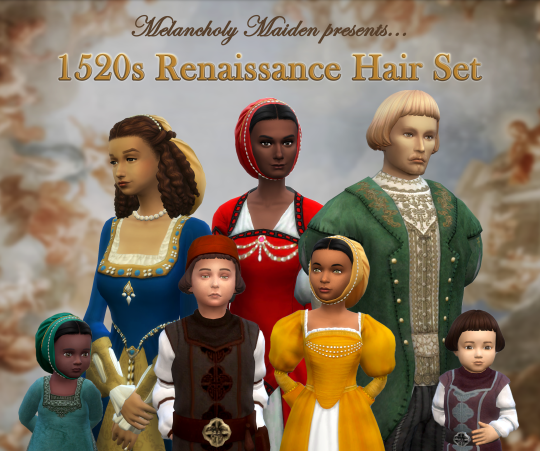
Renaissance Hair Set
Here is the set from the March CC vote! I wanted to get every last detail right and I'm proud to finally share this set with you all :). I made sure to include content for more ages this time too!
DOWNLOAD (FREE)
#sims4cc#sims 4 historical#download#historical cc#maxis match#ts4cc#sims 4 hair#renaissance cc#tudor cc
422 notes
·
View notes
Text

Portrait of Uriel Septim VII at the age of 87. Imperial City. Year: Winter—Spring 3E 433.
On 27th Last Seed (August) the Emperor was assassinated by (supposedly) Daedric Cultists.
P.S: Cyrodiil is a jungle.
#morrowind#elder scrolls#tamriel#oblivion#tes#tesblr#uriel septim#tudor fashion#cyrodiil#uriel VII#tes lore#digital art#baroque#digital painting#crpg#tes 4 oblivion#oblivion mods#renaissance fantasy#septim dynasty#tes art#the elder scrolls#kritaart#krita#made with krita#artwork#art
181 notes
·
View notes
Text
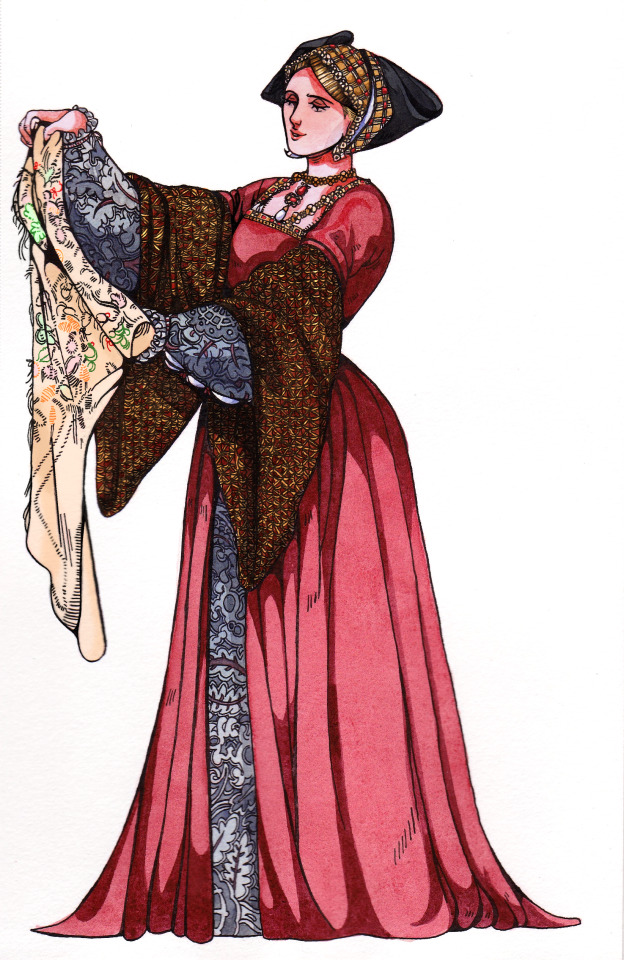
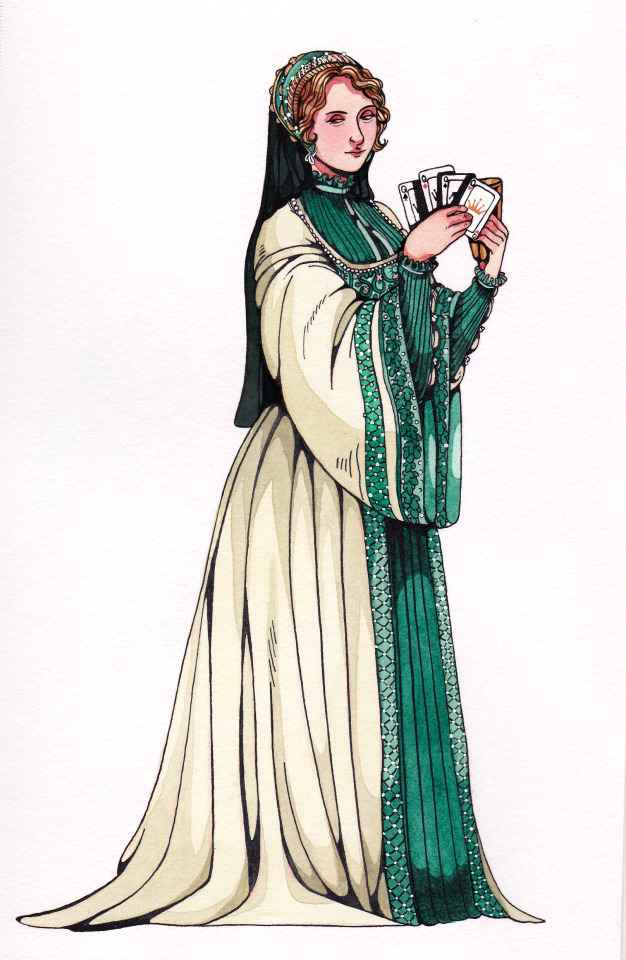
Next two of Henry VIII's wives: Jane Seymour and Anne of Cleves!
Putting a little explanation for these designs under the break:
Both of these women were painted by Hans Holbien, and their portraits by that artist played a pretty vital role in how I wanted to depict these women. For Jane, I decided to stick as close as I could, because I think Jane gets the most artistic interpretation than any of the other wives. She's a blank slate to a lot of directors in Tudor adaptations. This is brought on by the very scant records we have of what she was really like in life. We do know she loved quail while she was pregnant, and encouraged Henry to treat his daughter Mary better, which ultimately ended in her being welcomed back at court. Her family has kept samples of her embroidery through history, so it's fun to imagine her working on something in between breaks for her portrait.
For Anne, I went the complete opposite. Her Holbien portrait is extremely famous, but I feel like it creates the misconception that Anne never changed during the rest of her life in England. The portrait also has been used to cast doubts on her appearance (and whether or not her looks are exagerrated). In reality, Anne was dressed in typical English court digs when she arrived in England, and was noted to be very pretty. It wasn't until after Henry cast doubts on her appearrance, and even her chastity, in order to get out of the marriage as quickly as possible. I wanted to give these back to her, as white symbolised purity and chastity in this period. Anne lived a good life as Henry's sister, and outlived all the other of Henry's wives. She was known for being kind to her staff, and loving to pair cards with a good drink.
#henry viii#tudor history#tudors#jane seymour#anne of cleves#six wives of henry viii#illustration#watercolor#ink#renaissance history#fashion history#also anne of cleves is my favorite but don't tell the others because i love them all
685 notes
·
View notes
Text
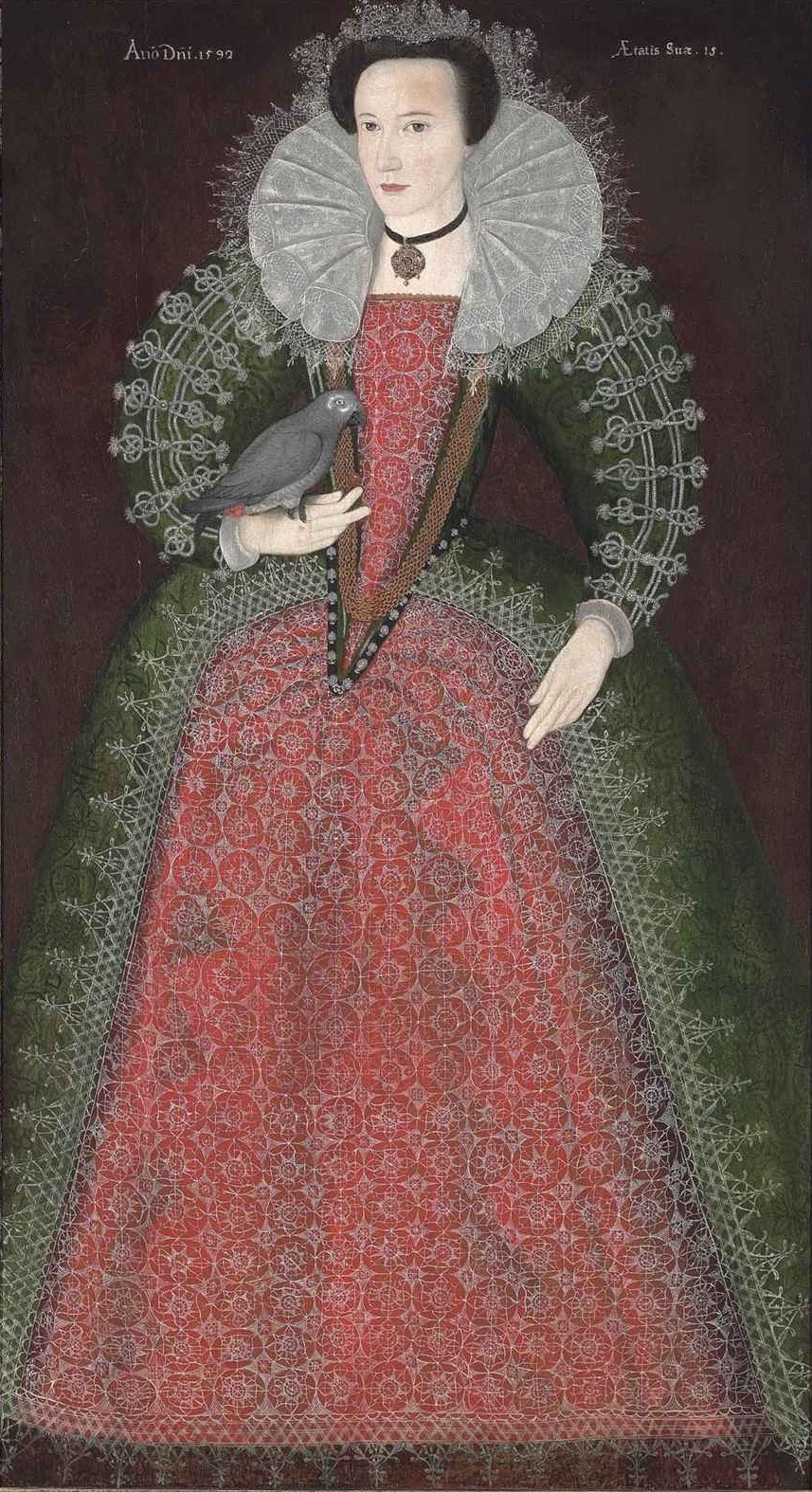
Portrait of a Lady with a Parrot, unknown artist (English School), 1592
#art#art history#English School#portrait#portrait painting#Tudor England#Elizabethan England#English Renaissance#English art#16th century art#oil on panel
151 notes
·
View notes
Text

Alternate Yule ball outfits for my mc and Sebastian, inspired by Tudor fashion.
I know the time setting is the Victorian era but just hear me out- okay— please.
#renaissance >>>>>#they love matching their outfits#its probably Ag's idea#hogwarts legacy#hphl mc#hphl oc#hphl#agatha crowley#hogwarts legacy mc#hogwarts legacy oc#sebastian sallow#sebastian sallow x mc#sebastian sallow x oc#sebastian x mc#slytherin#hogwarts#hogwarts oc#tudor fashion#yule ball#my art
556 notes
·
View notes
Text

Stained glass window in the Chapel of Trinity College, Cambridge. The college was founded by Henry VIII in 1546.
#mary tudor#mary i of england#mary i#history#the tudors#henry viii#stained glass#light acadamia aesthetic#gothic#aesthetic#renaissance art#english
212 notes
·
View notes
Photo



‘It's not every day that new Tudor artifacts are discovered. Earlier this morning, researchers at the British Museum announced the discovery of a heart-shaped gold pendant, attached to a gold chain, dated to around 1521. Perhaps the most significant part of this discovery is the interwoven 'H' and 'K' initials, confidently linking this find back to Henry VIII and his first wife, Katherine of Aragon.
It is possible that this pendant was part of the Tudor court's famed pageantry. It may have been presented to Queen Katherine by Henry himself at a jousting tourney at Westminster, intended to celebrate the birth of their son, Prince Henry, Duke of Cornwall. However, that would place the pendant's origins to January of 1511 at the latest.
At the tournament, King Henry proudly wore symbols of the heart, Katherine's initials, and Katherine's emblem – a pomegranate – woven throughout his clothes and resplendent caparisons. He spared no expense for the celebrations, although sadly, his son Henry, would breathe his last less than a month later.
Little of the object's provenance has been revealed. It was discovered by a metal detectorist in a field in the Midlands, who 'shrieked like a school girl' upon unearthing the pendant. Hopefully in the coming months, more information about this enigmatic object will be released.’
Source: TudorExtra on Instagram
#tudor history#Tudor Dynasty#the tudors#katherine of aragon#catherine of aragon#henry viii#renaissance#early modern#archeaology
1K notes
·
View notes
Text
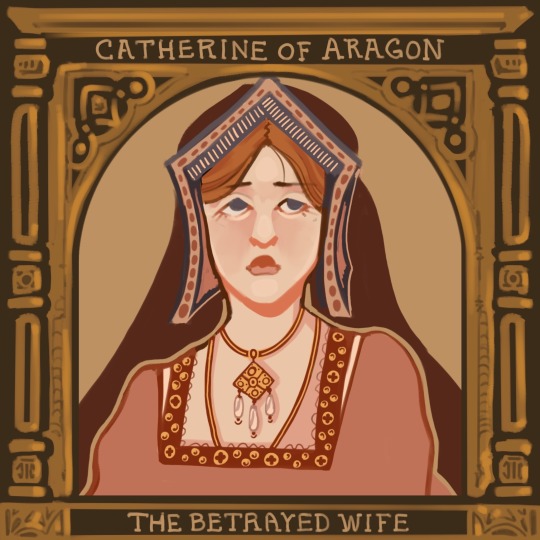



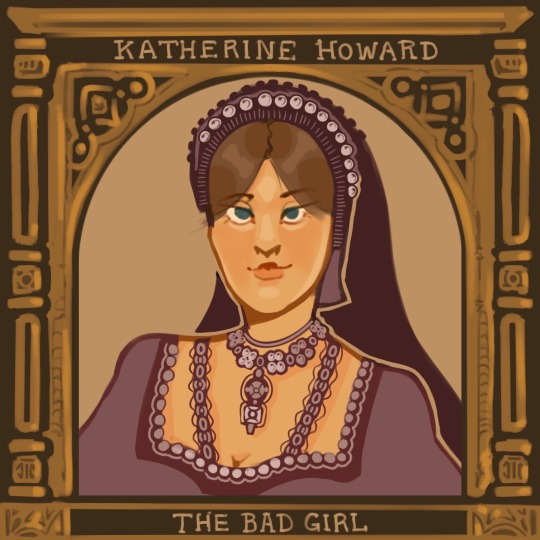

1. Catherine of Aragon (married 1509-1533)
motto: HUMBLE AND LOYAL
Even allowing for tactful hyperbole, it is clear that Catherine, […] did have the kind of youthful prettiness and freshness of appearance that charmed observers, not only the family into which she would marry. It was partly a question of her complexion: her naturally pink cheeks and white skin were much admired in an age when make-up was clumsy in execution, easy to detect and much scorned. Ambassadors abroad, describing princesses to their masters, generally emphasized the tint of the skin, carefully noting whether it was 'painted' or not. A fair complexion like Catherine's was thought to indicate a more serene and cheerful temperament than a 'brown' one. Then Catherine's hair was also fair and thick, with a reddish-gold tint, her features neat and regular in a pleasingly shaped oval face.
Perhaps Catherine's fair colouring, so far from the conventional picture of a dark-visaged Spaniard, reminded onlookers of her one-eighth of English blood: […] 'there is nothing wanting in her that the most beautiful girl should have. '
If her complexion was her chief beauty, Catherine's chief disadvantage was her lack of height. All the grace of her bearing, inculcated over many years at the Castilian court, could not conceal the fact that she was extremely short, even tiny. Years later a loyal defender had to admit that she was 'in stature somewhat mean', while adding quickly 'but bonarly [bonnie] withal'. She was also on the plump side - but then a pleasant roundness in youth was considered to be desirable at this period, a pointer to future fertility. In contrast Catherine's voice was surprisingly low and 'big-sounding' for a woman; and that no doubt contributed to the impression of gracious dignity she left on all observers, making up for the lack of inches.
2. Anne Boleyn (married 1533-1536)
motto: THE MOST HAPPY
Anne Boleyn was not a great beauty. The Venetian ambassador […] pronounced her 'not one of the handsomest women in the world'. […] Anne Boleyn was only moderately pretty.
Some of this lukewarm praise may have been due to the fact that her looks did not accord with the fair-haired, blue-eyed ideal of the time. In theory, dark looks were regarded with suspicion and Anne Boleyn's looks were conspicuously dark: she was 'Brunet' […] Anne Boleyn's olive complexion’ […] her colouring 'rather dark' or sallow 'as if troubled with jaundice', or 'not so whitely as ... above all we may esteem.' She did have a few moles, although she was hardly disfigured by them on the contrary they acted as beauty-spots. Her hair, thick and lustrous as it might be, was extremely dark […] And her eyes were so dark as to be almost black. But then the theory of public admiration was one thing - blondes were supposed to be of cheerful temperament - and the practice of physical attraction was quite another. Clearly in adulthood Anne Boleyn exercised a kind of sexual fascination over most men who met her; whether it aroused desire or hostility, the fascination was there.
The black eyes were sparkling and expressive; and they were set off by those 'dark, silky and well-marked eyebrows' […] on the subject: she knew well how 'to use [her eyes] with effect', whether deliberately leaving them in repose or using them to send a silent message which carried ‘the secret testimony of the heart'. As a result many became obedient to their power. More prosaically, the Venetian ambassador called her eyes "black and beautiful'. Her mouth, described by him as 'wide' (another theoretical disadvantage by the standards of the time), was recorded by Sander as pretty. […] Anne Boleyn was 'of middling stature' (which made her of course a great deal taller than Queen Catherine). She seems to have been quite slight or at any rate not full-breasted - the Venetian ambassador remarked that her bosom was 'not much raised' […]. But a much more important aspect of her appearance when she first came to court was her elegant long neck; this, with the deportment she had learned in France […] gave her a special grace, especially when dancing, which no one denied.
The fresh young damsel had other qualities, some more obvious than others at the moment of her arrival back in England. She had 'a very good wit', wrote Cavendish in his Life of Wolsey, another source not prejudiced in Anne Boleyn's favour? The phrase, going beyond mere intelligence, carried with it connotations of spirit and adventurousness; in other words, Anne Boleyn was good company. Like many spirited people, she had another more impatient side to her: she would display on occasion a quick temper and a sharp tongue. But of these characteristics, deplored in a woman as much as skill at singing and dancing was prized, there was as yet no sign.
3. Jane Seymour (married 1536-1537)
motto: BOUND TO OBEY AND SERVE
From other sources, it seems likely that the charm of her character considerably outweighed the charm of her appearance: […] of middle statute and no great beauty. Her most distinctive aspect was her famously pure white complexion. Holbein gives her a long nose, and firm mouth, with the lips slighty compressed, although her face son a pleasing oval shape with the high forehead then admired (enhanced sometimes by discret plucking of the hairline) and set off by the headdresses of the time. Altogether, if Anne
Boleyn conveys the fascination of the new, there is a dignified but slightly stolid look to Jane Seymour, appropriately reminiscent of English medieval consorts.
But the predominant impression given by her portrait - at the hands of a master of artistic realism - is a young woman of calm good sense. And contemporaries all commented on Jane Seymour's intelligence: in this she was clearly more like her cautious brother Edward than her dashing brother Tom. She was also naturally sweet-natured (no angry words or tantrums here) and virtuous - her virtue was another topic on which there was general agreement. There was a story that she had been attached to the son of Sir Robert and Lady Dormer, a country neighbour, but was thought of too modest a rank to marry him; even if true, the tale brought with it no slur on Jane's maidenly honour. It was told more as a Cinderella story, where the unfairly slighted girl would go on to be raised triumphantly to far greater heights. Her survival as a lady-in-waiting to two Queens at the Tudor court still with a spotless reputation may indeed be seen as a testament to both Jane Seymour's salient characteristics - virtue and common good sense. A Bessie Blount or Madge Shelton might fool around, Anne Boleyn might listen or even accede to the seductive wooings of Lord Percy: but Jane Seymour was unquestionably virginal.
In short, Jane Seymour was exactly the kind of female praised by the contemporary handbooks to correct conduct; just as Anne Boleyn had been the sort they warned against. There was certainly no threatening sexuality about her. Nor is it necessary to believe that her 'virtue' was in some way hypocritically assumed, in order to intrigue the King […]. On the contrary, Jane Seymour was simply fulfilling the expectations for a female of her time and class: it was Anne Boleyn who was - or rather who had been - the fascinating outsider.
4. Anne of Cleves (married 1540-1540)
motto: GOD SEND ME WELL TO KEEP
Let us take the actual appearance of Anna of Cleves first: for this we are fortunate in having a first-hand description, written only a few days later by the French ambassador, Charles de Marillac, who was not prejudiced in either direction, towards her beauty or her ugliness. Anna of Cleves looked about thirty, he wrote (she was in fact twenty-four), tall and thin, 'of middling beauty, with a determined and resolute countenance.' The Lady was not as handsome as people had affirmed she was, nor as young […], but there was a steadiness of purpose in her face to counteract her want of beauty.
The 'daughter of Cleves' was solemn, or at any rate by English standards she was, and she looked old for her age. She was solemn because she had not been trained to be anything else and the German fashions did little to give an impression of youthful charm in a court in love as ever with things French, or at any rate associating them with fun and delight. […] Turning to Holbein's picture, one finds this solemnity well captured: a critic might indeed term it stolidity. Besides Wotton, in his report, had confirmed that Holbein, generally regarded as the master of the 'lively' or lifelike (not the flattering) in his own time, had indeed captured Anna's "image' very well.
Of course a beautiful young woman, however stolid or badly dressed, would still have been acceptable. Anna of Cleves was not beautiful, and those reports which declared she was were egregious exaggerations in the interests of diplomats […]. But was Anna of Cleves actually hideous? Holbein, painting her full-face, as was the custom, does not make her so to the modern eye, with her high forehead, wide-apart, heavy-lidded eyes and pointed chin.
There is indirect evidence that Anna of Cleves was perfectly pleasant-looking from the later years of Henry VIII. When Chapuys reported Anna of Cleves as rating her contemporary, Catherine Parr, 'not nearly as beautiful' as herself, this expert observer did not choose to contradict her; so that the boast was presumably true, or at least true enough not to be ridiculous.
5. Katherine Howard (married 1540-1542)
motto: NO OTHER WILL BUT HIS
No confirmed authentic picture of Katherine Howard survives. The fact that Katherine Howard is the only one of Henry VIII’s wives for whose appearance we must rely properly on contemporary descriptions, gives her career an appropriately evanescent quality. The same mistiness surrounds her date of birth. She was eighteen or nineteen when the King’s roving eye first fell upon her: that is, roughly thirty years younger than he was. […] Katherine was not only small, as Catherine of Aragon had been, but diminutive: parvissima puella – a really tiny girl. If King Henry was about thirty years older than Katherine, he must have been well over a foot taller. We need not speculate further about their respective weights. The French ambassador rated her beauty as only middling (the same phrase he had used for Anna of Cleves, incidentally), but he did praise her gracefulness, and he found much sweetness in her expression; her habit of dressing à la française (as opposed to Anna of Cleves’ Germanic fashions) no doubt commended itself to him.
Even if Katherine Howard was not a beauty, she must have had considerable prettiness and obvious sex appeal (as well as – or perhaps because of – her youth) since we know that she captivated the King instantly.
6. Catherine Parr (married 1543-1547)
motto: TO BE USEFUL IN ALL I DO
The woman who brought about this cheerfulness, the new Queen Catherine Parr, was herself never described by anyone as a beauty: even the term ‘of middling beauty’ used for both Anna of Cleves and Jane Seymour by Marillac was not applied in this case. ‘Pleasing’ and ‘lively’, ‘kind’ and ‘gracious’ were the most flattering epithets ascribed to her. It is true that a difference of age and status may have been responsible for this lack – widows of over thirty were not expected to be beauties – but when Anna of Cleves indignantly exclaimed that the new Queen was ‘not nearly as beautiful as she’, Chapuys, passing on the comment, did not see fit to contradict it.
Queen Catherine Parr’s only known authentic likeness, attributed to William Scrots, shows an amiable face rather than an intriguing one; the nose is short, the mouth small, and the forehead broad rather than domed in the way that contemporaries admired. Her hair was rather similar in colour to that of Catherine of Aragon: light auburn, tinged with what Agnes Strickland in the nineteenth century would call ‘threads of burnished gold’.
But if the new Queen Catherine was not a beauty, she was neither dull nor austere. She enjoyed dancing. […] She was well set up – the tallest of King Henry’s wives – and her height would have enabled her to cut a regal figure since her conception of her role as queen consort also included a great deal of ornate dressing-up.
Bibliography:
- Fraser, Antonia. The Six Wives of Henry VIII. New York Knopf, 1993.
#henry viii#princess catherine#catherine of aragon#anne boleyn#queen anne#jane seymour#anne of cleves#katherine howard#catherine parr#procreateart#digitaldraw#digitalillustration#renaissance#medieval#english history#monarchy#the tudors#king henry viii#quotes#illustration#england
139 notes
·
View notes
Text



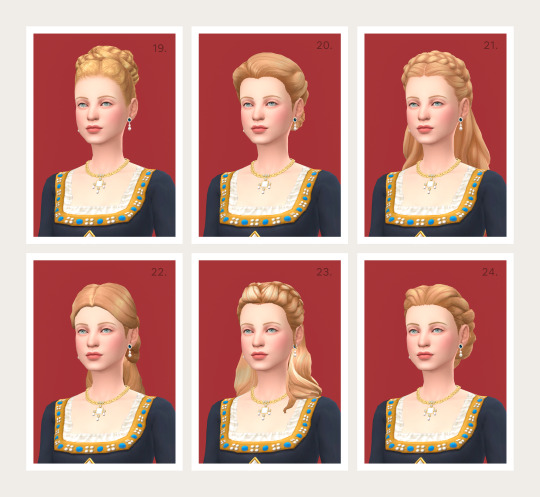

The 1500s was a century of innovation when it came to hairstyles, with the introduction of both metal hair pins (1545) and wigs (1572). These pins were used to hold wires and pads in place that essentially acted as scaffolding for the shaped hairstyles popular during this period. The religious modesty of previous centuries was cast aside for the first time, with young married women now uncovering their tresses. The ideal hair was curly and fair or red, a fad influenced by British monarch Queen Elizabeth I. CC links and reference images under the cut.
You can find more of my historical content here: 1300s ✺ 1400s ✺ 1500s ✺ 1600s
1 - Queen of Curls by Teanmoon
2 - Beatrix by Sims to Maggie
3 - Mary's Braid Bun by Birksche
4 - Circle Braid by Simverses
5 - Rose Braid by Simverses
6 - Marzia by Talented Trait
7 - Princess Hair by Nightingale Songx
8 - Ethel by Buzzard's Bits and Bobs
9 - Rhaenyra by Sims to Maggie
10 - Queen of Quaff by Teanmoon
11 - Hilda by Birksche
12 - Gaia by QICC (Curse Forge)
13 - Ally Afro Puff V1 by Sheabuttyr
14 - Winifred by Simduction
15 - Betsy by Sims to Maggie
16 - Phaedra by Simple Simmer
17 - Verity by Birksche
18 - Rirrier by Carol Forest
19 - Twisted Bun by Birksche
20 - Nora by Buzzard's Bits and Bobs
21 - Gytha by Buzzard's Bits and Bobs
22 - Gentle Hair by Kiara Zurk
23 - Long Hair Braid by Birksche
24 - Isabel by Sims to Maggie
25 - Judy's Half Braids by Birksche
26 - Sunshine Braid by Kiara Zurk
27 - Wrap Around Braid by Leeleesims1
28 - Duna by Buzzard's Bits and Bobs
29 - Becca by aharris00britney
30 - Lucrezia by Tekri

With thanks to some amazing creators: @teanmoon @simstomaggie @simverses @talentedtrait @nightingalesongx @buzzardly28 @sheabuttyr @simduction @blogsimplesimmer @leeleesims1 @aharris00britney @tekri
#ts4#ts4 cc cas#the sims 4#ts4 decades challenge#sims 4 decades challenge#ts4 cc hair#ts4 historical#ts4 history challenge#sims 4 history challenge#sims 4 historical#1500s#historical cc#tudor#16th century#ultimate decades challenge#hair collection#renaissance
579 notes
·
View notes
Text
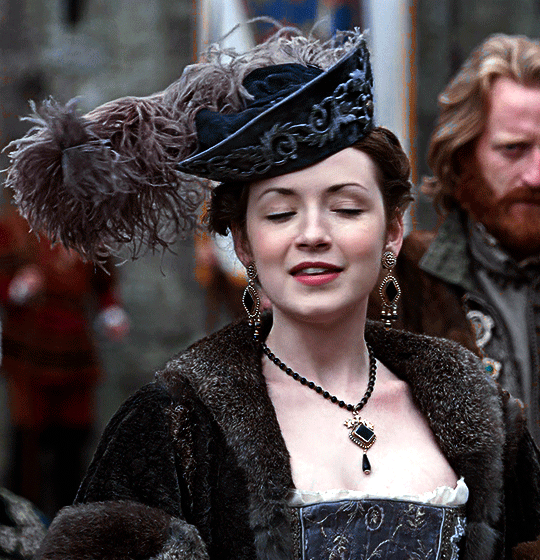
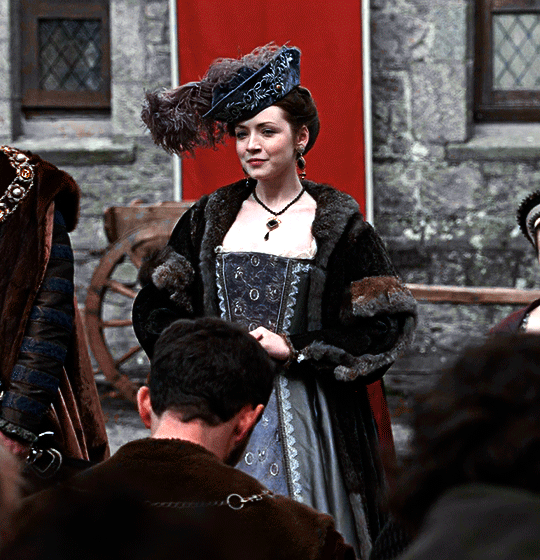

Sarah Bolger as Mary Tudor
The Tudors (2007-2010)
#the tudors#mary i#mary tudor#sarah bolger#period drama#period dramas#tudoredit#thetudorsedit#thetudorsgifs#perioddramagif#perioddramaedit#perioddramacentral#perioddramasource#weloveperioddrama#costumeedit#tudorerasource#renaissance era#tudor era#costume#❦ I make gifs ❦
564 notes
·
View notes
Photo
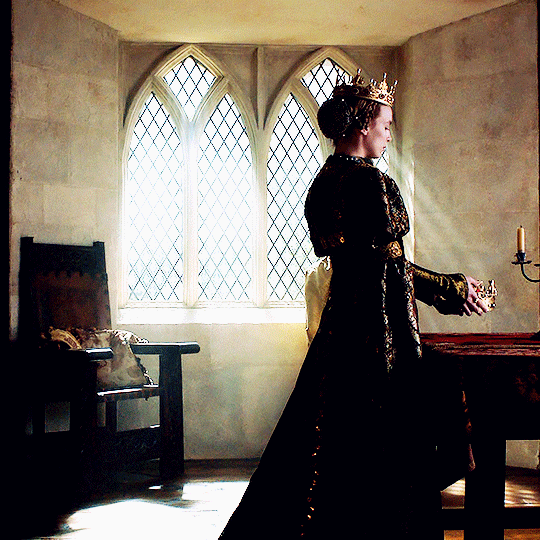



You will always be by my side? Always.
Elizabeth of York and Henry VII, The White Princess (2017)
#twpedit#perioddramaedit#the white princess#jodie comer#jacob collins levy#elizabeth and henry#elizabeth of york#henry vii#historical#royalty#crown#period drama#medieval#renaissance#15th century#england#tudors#my edits#anyway here's a gifset that i started in 2020#and for some reason my brain was like 'let's do it now!'#now i was able to use the blu ray directly
661 notes
·
View notes
Text
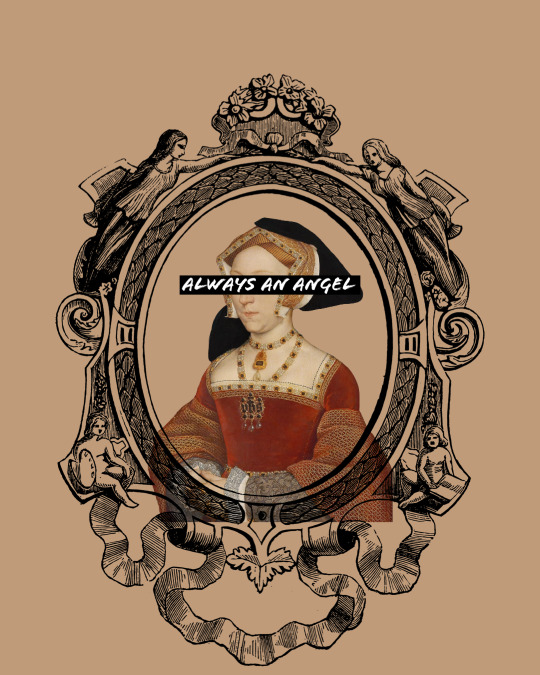
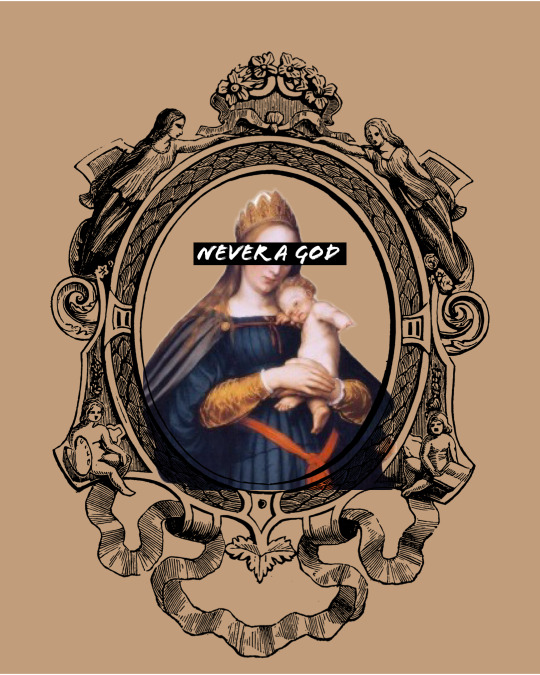
Not Strong Enough by boygenius x Queen Jane Seymour and Darmstadt Madonna by Hans Holbein the Younger
#jane seymour#tudor history#the tudors#tudor era#english history#darmstadt#madonna#hans holbein the younger#Hans Holbein#tudor england#northern renaissance art#northern renaissance#renaissance art#reniassance#boygenius#phoebe bridgers#lucy dacus#julien baker#16th century art#16th century#sixteenth century#1500s#1500s art#queen jane seymour#henry viii
82 notes
·
View notes